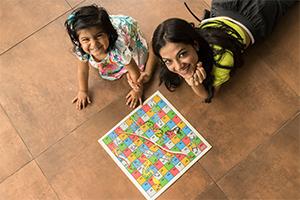Learning and Teaching

LEARNING DIRECTIONS
Supporting numeracy at home
By Dr Simon Lindsay, General Manager, Improved Learning Outcomes and James Giannopoulos, Team Leader, Mathematics, Improved Learning Outcomes, at Melbourne Archdiocese Catholic Schools (MACS).
Is it harder to support children’s numeracy at home than it is literacy? National Assessment Program Literacy and Numeracy (NAPLAN) data from states where children spent longer periods in remote learning would seem to indicate that it is. The lockdowns due to the COVID-19 pandemic over the previous two years cast the role of the family in children’s learning into the spotlight, with many parents and carers anxious about the extent to which they could support their children’s learning, particularly in numeracy.
However, research shows that parents and carers can give their young children a boost in learning mathematics by noticing, exploring and talking about maths during everyday activities at home or out and about (Phillipson, Gervasoni & Sullivan 2017). This research further shows that parents play a key role in helping their children learn mathematics concepts involving time, shape, measurement and number. This mathematical knowledge developed before school is predictive of literacy and numeracy achievements in later grades.
The Let’s Count longitudinal evaluation findings, for example, show that when early years educators encourage parents and families to confidently notice, explore and talk about mathematics in everyday activities, their young children’s learning flourishes (Smith Family 2015).
What parents and carers can do to promote maths every day
Research also shows that one of the biggest barriers to parents and carers engaging in conversation about maths is their lack of confidence in leading maths education at home (Phillipson, Gervasoni & Sullivan 2017; Maloney et al. 2015). Through examining international research, the following types of activities were identified as important for early maths learning, which are easy for parents to use. These include:
- ‘Comparing objects and describing which is longer, shorter, heavier or holds less.
- Playing with and describing two-dimensional shapes and three-dimensional objects.
- Describing where things are positioned, for example, north, outside, behind, opposite.
- Describing, copying, and extending patterns found in everyday situations.
- Using time-words to describe points in time, events and routines (including days, months, seasons and celebrations).
- Comparing and talking about the duration of everyday events and the sequence in which they occur.
- Saying number names forward in sequence to 10 (and eventually to 20 and beyond).
- Using numbers to describe and compare collections.
- Using perceptual and conceptual subitising (recognising quantities based on visual patterns), counting and matching to compare the number of items in one collection with another.
- Showing different ways to make a total (at first with models and small numbers).
- Matching number names, symbols and quantities up to 10’ (Phillipson, Gervasoni & Sullivan 2017).
Games to play using everyday situations
Neuroscience research has provided crucial evidence about the importance of early nurturing and support for learning, brain development, and the development of positive dispositions for learning (ZERO to THREE 2022).
There are plenty of everyday games and activities that can boost children’s mathematics learning. For example:
- talk with children as you prepare meals together
- talk about measuring and comparing ingredients and amounts
- look at maps, shapes and money
- play children’s card games and games involving dice, such as snakes and ladders.
Although these activities may seem simple and informal, they build on what children notice and question, give families the chance to talk about mathematical ideas and language, and show children that maths is used throughout the day.
Make it relevant to them
Perhaps most importantly, one of the best ways for children to get into maths is to by making it appealing and relevant to them.
During everyday activities with children, such as walking down the street or sitting in the park:
- bring their attention to the objects around them that they are interested in – houses, cars, trees, signs
- guess the distance walked, in order to create a mental benchmark of metres and kilometres
- look at insects or small pebbles, highlighting millimetres or centimetres to encourage the need of using appropriate different metric units
- talk about the shapes and sizes of the objects, talk about and look for similarities and differences (for example, let’s find a taller tree or a heavier rock)
- count the number of cars parked in the street or time how long it takes to reach the next corner
- talk about the shapes within the objects, or the sizes of the objects
- talk about and look for similarities and differences (for example, let’s find a taller tree or a heavier rock)
- count the number of cars parked in the street or time how long it takes to reach the next corner
- discuss the temperature and how that feels
- discuss the speed of your walking pace
- explore sharing and dividing objects that are whole or in half to develop the understanding of equal groups and fairness.
It is never too soon to begin these activities. Babies who are only weeks old notice differences in shapes and the number of objects in their line of sight.
So, from the earliest of ages, talk with your child about the world around them, being descriptive and using mathematical words. As they grow, build on what they notice about shapes, numbers and measures.
What is MACS doing to support learning at home in maths
In recognition of the value of the home environment in mathematics learning, the MACS Mathematics team is working in partnership with Prof. Sivanes Phillipson PhD, Professor of Education at Swinburne University of Technology.
Together, we are developing an asynchronous professional learning module to support Mathematics leaders in schools, as part of our BEEM (Building Excitement and Engagement in Mathematics) project. Mathematics leaders will be working closely with their parent communities to provide them with knowledge around every day mathematics and questions they could ask at home to support the learning and teaching of mathematics.
The aim of the project is to:
- support parents to develop a positive attitude towards mathematics and to gain a better understanding of how mathematics is taught in the 21st century
- highlight the importance for parents to engage with their child/ren in their experiences of learning mathematics
- reinforce the significance of establishing positive learning experiences at home
- make strong connections between the learning in classrooms to the learning at home
- educate and empower parents on key strategies that are being taught in mathematics today.
As part of the partnership with Swinburne University, MACS schools and their parent communities have access to a resource site, Numeracy@Home, which contains many examples and tips of how parents can engage in mathematics with their young children in everyday situations.
We are also supporting schools by providing Get in2 Maths home kits, including examples of resources such as measuring tapes, playing cards, dice, counters and games that schools can send home to their parent community to encourage conversations and mathematics learning, thus building excitement and engagement in mathematics at home.
This community approach to improving maths education is increasingly shown in research to support learners to flourish in maths. ‘When schools, families and community groups work together to support learning, children tend to do better in school, stay in school longer, and like school more’ (Henderson & Mapp 2002, p. 7).
References
Henderson, A & Mapp, K (eds) 2002, A New Wave of Evidence: The Impact of School, Family, and Community Connections on Student Achievement, Southwest Educational Development Laboratory (SEDL), Texas, accessed 2 May 2022 https://sedl.org/connections/resources/evidence.pdf.
Maloney EA, Ramirez G, Gunderson EA, Levine SC, Beilock SL 2015, ‘Intergenerational Effects of Parents’ Math Anxiety on Children’s Math Achievement and Anxiety’, Psychological Science, 26 (9), 1480–1488.
Phillipson, S, Gervasoni, A & Sullivan P (eds) 2017, Engaging Families as Children’s First Mathematics Educators: International Perspectives, Springer, Singapore.
The Smith Family 2015, Strengthening early numeracy learning: The Let’s Count program, The Smith Family, Sydney, accessed 2 May 2022 www.thesmithfamily.com.au/-/media/files/research/reports/lets-count-research.pdf.
ZERO TO THREE 2022, ZERO TO THREE: Early connections last a lifetime, ZERO TO THREE, Washington DC, accessed 2 May 2022 www.zerotothree.org.
Dr Simon Lindsay and James Giannopoulos can be contacted on 9267 0228 or via email slindsay@macs.vic.edu.au or jgiannopoulos@macs.vic.edu.au.

